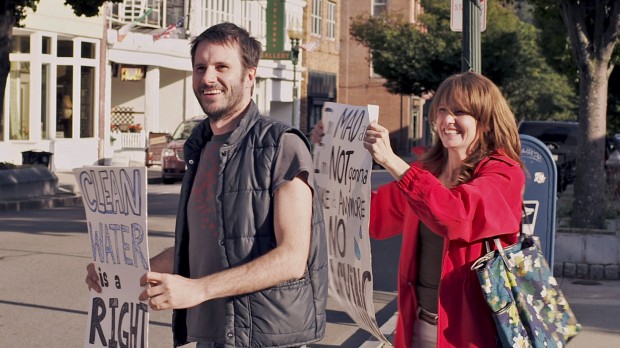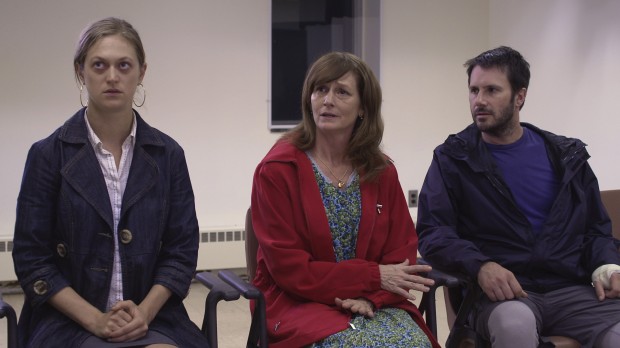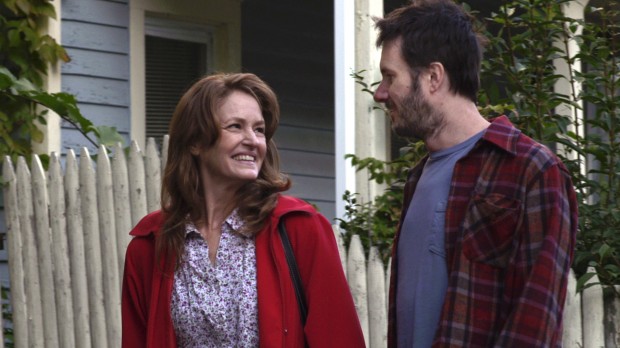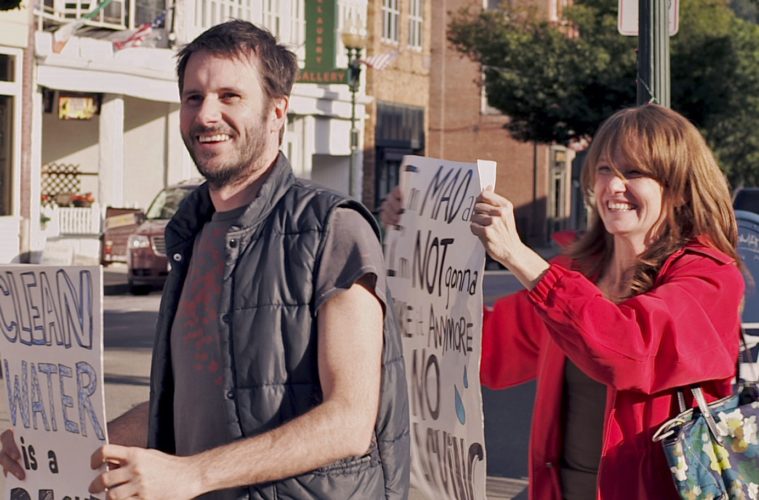
Speaking with Enid Zentelis about her new film Bottled Up, two things become clear: how personal the story is to her and how determined the female filmmaker was to tell the story her way. Her first feature, Evergreen, ran the festival circuit in 2004. Nine long years later, she’s back with this refreshingly different take on addiction in all of its forms. For more on the film, you can read our review here.
Zentelis talked on everything from perfect movie endings to what a world looks like ruled by stuffy white male critics. Check out our conversation below.
TFS: You’re first film, Evergreen, came out in 2004. Here we are, 9 years later, with Bottled Up. What’s that journey like for you?
Zentelis: Well, I guess there’s a lot. While I didn’t have another feature made in that interim, I did some films. I did a film with [Bill] Clinton, I did a film with some bands [including Wilco]. I did some commercial directing and I was trying to get a couple of other projects off the ground, which almost went. And then I had 2 kids. Before you know it, it’s that amount of time. And to get back into it, I wrote the script for [Bottled Up] maybe three years ago. So even though this day marks so many years later, it sounds so long when people word it that way.
It’s funny, though, because I have good friends here [at Tribeca], also female directors, that are all here with their second features. All of our first films came out at the same time so, it is tough. I’m hoping it doesn’t take so long [for the third film]. I’m definitely not having any more children, so that’s going to help. Shave 4 years off the process.
 From your viewpoint, what are the big differences between the first feature and the second feature, in terms of your process as a whole?
From your viewpoint, what are the big differences between the first feature and the second feature, in terms of your process as a whole?
Well, also in that interim I started teaching [at NYU]. That’s a great thing to do while having kids, to have a more regular schedule. When you’re hustling for work you can’t be there at bed time. The great benefit of [a regular schedule] is really honing my skils and reexaming what I feel about directing and writing because I’m teaching both of those things in volume at NYU. There’s nothing that makes you better at that thing then having to articulate it to others. That’s the biggest difference, is I feel I’ve gotten many times smarter. I’ve gotten much more time to think about my approach to things and where I want my work to go artistically. Aesthetically, how I want to visualize things has stayed the same. I mean it’s refined and hopefully I’ve grown. I know how to better execute them and hopefully next time I’ll have more than 18 days and a bigger budget.
[Laughs]
I basically had to pick one or two moments in the whole film to execute, stylistically, scenes that you aren’t really allowed to do in that time period. You know, I’m a big fan of Paul Thomas Anderson and that style. For that kind of approach you need time. We were shooting 13 to 14-page days consistently.
How long was the shooting script?
Over a hundred pages. I didn’t get to shoot everything. I didn’t have enough time. So I had to, as we were going, make those choices. Which is why I’m so proud of [the scene between Sylvie, Fay and Becket in the zoo in Canada] because of what I was able to do in 3 shots. It’s essentially 3 shots and I feel like they are very cinematic and I tell that story visually.
The way that this movie handles addiction is what jumped out to me. It is as much about the enabler as it is about the addict. And the film doesn’t judge either of these characters. How do you come to make a measured film about a topic like this?
The fact is, I’ve lived so closely to this tragedy, without revealing too much. It doesn’t dawn on one to go in and vilify someone. It’s about human beings and how they experience. In terms of Sylvie and how her body chemically reacts, and her personality, which is imperfect. She’s not an angel who then becomes an addict. She was a problematic and selfish before this. So I wanted to have this story set with real people. There’s so many real people affected by so many shades of addiction or enabling.
When you look at the landscape of stories about addiction its hard to find [commentary on those who enable]. I look at Days of Wine and Roses and Nicholas Ray’s Bigger Than Life. Those were the only films – a little bit with Mike Leigh’s Naked – that start with the characters.
In so many films it’s the addiction that’s the main character…
Right, [this film] is about the lives of these people, so it has to be pedestrian and it has to be…for me the comedy is a way for the audience to enter. And it’s never a comedy that’s slapstick, I’d never do that.
I think a lot of people have expectations of addiction films, which this is quickly characterized as. But when people come out of it it’s not what they would characterize it as first. But with those expectations, [Bottled Up] is always going to feel challenging, which I welcome.

Another thing that stands out are the strong female characters, particularly the character of Fay (played by Melissa Leo). It’s a role that’s unfortunately not available for actresses in that age bracket especially.
That too is a fight. They are ready to act, but it’s a fight to get it made and it’s a fight to get it well-received, no offense to you, by male critics. You know, it’s not the expected. I think the greatest thing I read about that was [New York Times film critic] A.O. Scott once when he was writing about Sideways. He wrote, ‘yeah, you know, I like this movie just fine’ but he felt the need to say that ‘all of us film critics are middle-aged white guys’ and that’s what they relate to and of course. You look for things that make you feel found. So it’s always going to be a little tough. But you got to do it because you believe in it, and I do so.
Was the film always going to be as funny as it is on the screen now?
Yes. These characters always had that life, always had that relationship. You need to be invested in Fay. You need to be with her and root for her the whole time. And therefore you cannot hate Sylvie (Marin Ireland). And therefore if she ends up with Becket (Josh Hamilton) he’s not some sort of opportunistic guy, nor he is he some turnip off the turnip truck. Fay is the emotional epicenter, so Sylvie has to be funny and charming. And Fay’s humor comes from us understanding how she gets through what she gets through. And Becket’s come from being behind the action, the man on the out, so he becomes funny.
This movie ends at the perfect moment. Right when all is resolved and we’re shown everything that needs to be shown, the movie ends. There’s not 5 more minutes of unnecessary conclusion, as there are in so many films. Where does that come from?
In terms of where the film ends, stylistically, that’s just my style. I don’t cover a moment 5 different ways and kill myself and second-guess myself. I don’t like to overstay, I like films that don’t overstay. They give you what you need emotionally and they leave and, in that way, your imagination still alights.
You’ve completed the highest moment of Fay’s emotional journey. We had another scene actually, that looks beautiful. It’s Fay in the garden and it’s outside and it just was not as strong an ending.
At the Q&A after the film, you mentioned how the ending of the film was very happy, and perhaps a bit unrealistic. Why this ending?
It’s a happy ending in that being a sort of a fantasy, because things rarely ever work out that way [in real life], certainly not that neatly. But with characters like this, you can believe [in this ending].
What’s next?
Well I have two projects that I’m really excited about. One was going to be my second film but didn’t go, and now has renewed interest. I shadowed an internal investigator at HSBC bank. So I have a new angle on that project where the lead character is this conservative, self-hating black man who is an investigator inside the bank. It’s bigger in terms of its narrative reach, big action big theme. But really again, I’m starting from that same thing; it’s this character’s world view. That he feels he’s got to be extra correct when the world around him appears so corrupt and is, in fact, so corrupt as we know now.
Then I have another set in Corsica. My parents are immigrants, my mother’s side of the family settled there after the Holocaust. It has a lot of refugees and ex-gangsters. It’s been a landscape and a part of my life that I’ve been constantly like, ‘how can I [tell this story]?’ Because it’s a lot. So I think I’ve found a way to do it. Its like a coming-of-age tale, but very different. I don’t know if you know the graphic novel American Born Chinese? The way that narrative spins where this kid’s trying to find his way, and there’s a tale of this Monkey King that’s this parallel. It’d be film magical realism in a way, but more in the style of Lucrecia Martel, the Argentinian filmmaker. But set in Corsica and I would be really excited to do it.

Bottled Up premiered at the Tribeca Film Festival.

